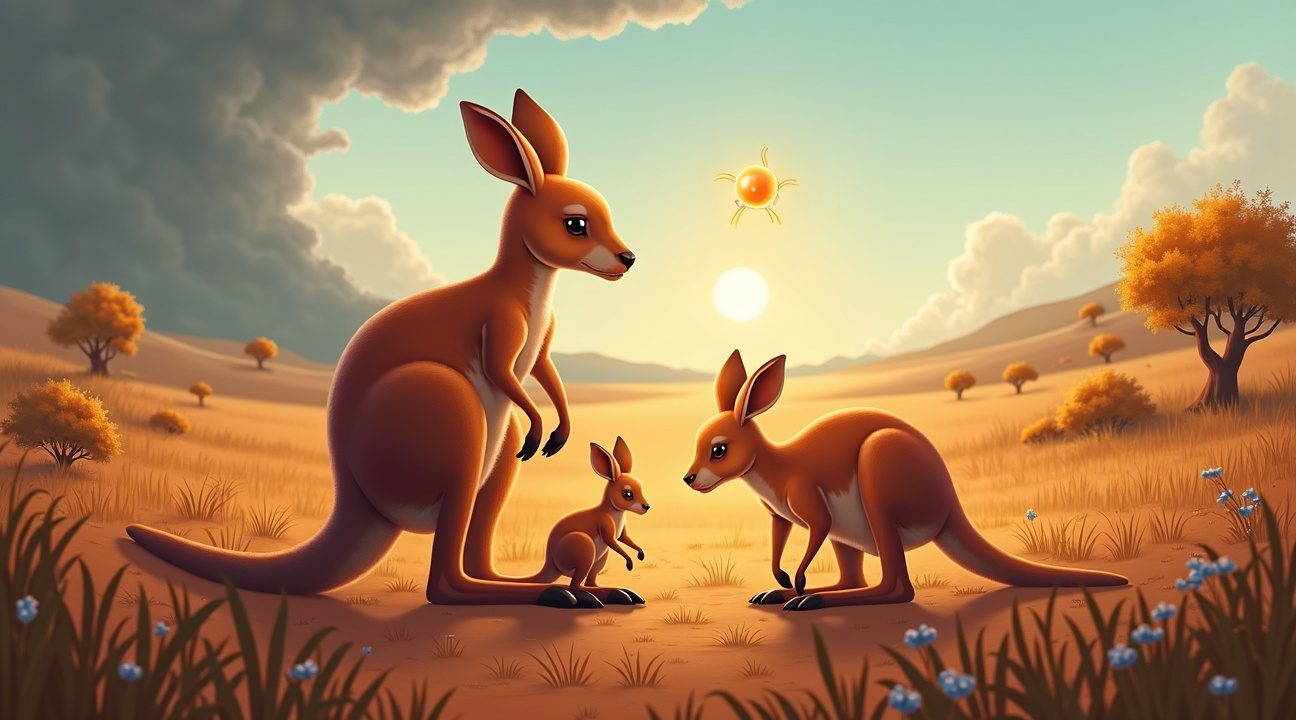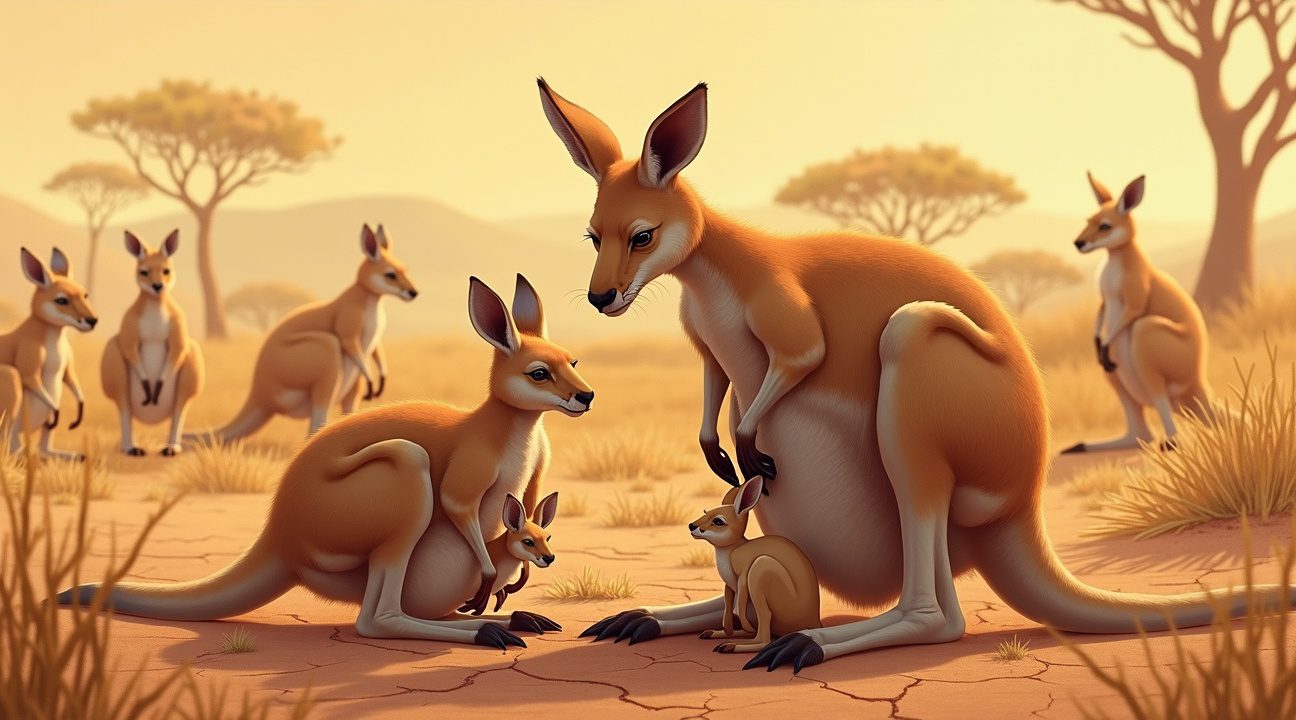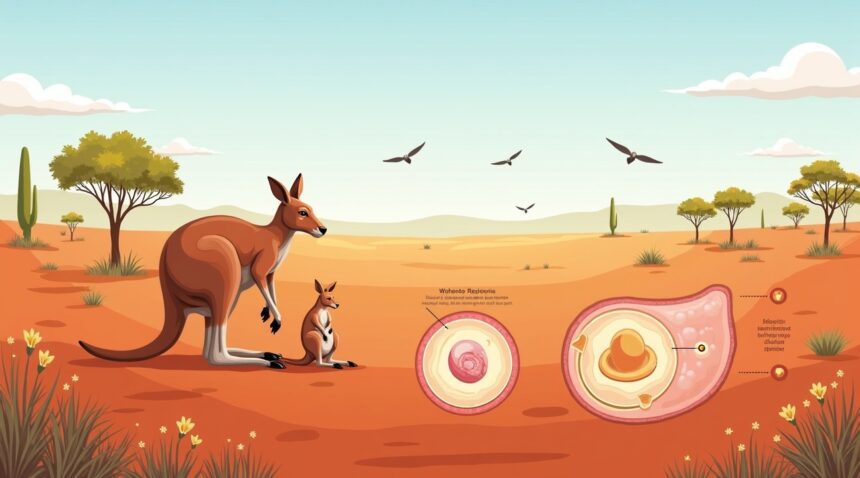Red kangaroos possess one of nature’s most remarkable reproductive adaptations: the ability to pause pregnancy for up to 11 months through a mechanism called embryonic diapause.
This extraordinary strategy allows these marsupials to time births perfectly with favorable environmental conditions, ensuring joeys arrive when mothers can provide adequate nutrition and survival rates are highest.
Key Takeaways
- Kangaroos can pause embryonic development for up to 11 months during harsh conditions like droughts or food scarcity, with the embryo remaining viable but dormant until environmental signals improve.
- Female red kangaroos can simultaneously manage three stages of offspring development: one dormant embryo in diapause, one joey nursing in the pouch, and one recently weaned joey still dependent on mother’s milk.
- Lactation serves as the primary internal trigger for diapause, with hormonal signals automatically pausing development of newly fertilized embryos while the mother focuses on her current offspring.
- Despite reproductive flexibility, kangaroos remain slow breeders with juvenile mortality rates reaching 75-100% during harsh conditions, meaning diapause prioritizes survival quality over quantity.
- This evolutionary strategy provides insurance against offspring loss and allows kangaroos to synchronize births with optimal environmental conditions rather than being locked into rigid seasonal breeding cycles.
Embryonic Diapause and Developmental Timing
Red kangaroos demonstrate nature’s capacity for reproductive innovation through embryonic diapause. Female kangaroos mate shortly after giving birth, yet they strategically delay the development of their newly conceived embryo. The embryo enters a state of suspended animation, consisting of only about 100 cells, and remains dormant until conditions become favorable for joey survival.
Environmental factors trigger the resumption of embryonic development. Food abundance, adequate rainfall, and seasonal changes signal the female’s body to release the embryo from its dormant state. Development then proceeds rapidly, with the joey born approximately 33 days later. This timing mechanism ensures offspring arrive when resources are plentiful and survival chances peak.
Hormonal Mechanisms Behind Diapause
The diapause mechanism operates through complex hormonal interactions. Prolactin, the hormone responsible for milk production, maintains the embryonic pause. High prolactin levels from nursing an existing joey prevent the dormant embryo from developing. Once the current joey reduces its nursing frequency or leaves the pouch permanently, prolactin levels drop and the paused embryo resumes growth.
Managing Multiple Offspring
Female red kangaroos often manage multiple offspring simultaneously through this system. A mother might nurse a large joey that visits the pouch occasionally, care for a smaller joey permanently residing in the pouch, and maintain a third embryo in diapause. Each offspring receives different milk compositions specifically formulated for their developmental stage, showcasing the sophisticated nature of kangaroo reproduction.
Diapause as a Survival Strategy
Diapause provides significant survival advantages in Australia’s unpredictable climate. Droughts can last for years, creating conditions where joey survival becomes nearly impossible. Rather than waste energy on offspring destined to perish, mothers maintain dormant embryos until environmental conditions improve. This strategy conserves maternal resources while ensuring reproductive success when conditions favor offspring survival.
Population Recovery Through Diapause
Research reveals that kangaroo populations can rapidly recover from harsh periods once favorable conditions return. The combination of diapause and the ability to breed year-round allows populations to bounce back quickly when food becomes abundant. Without diapause, recovery would take significantly longer since females would need to mate, gestate, and raise offspring from scratch after environmental improvements.
Conservation Applications
Scientists study kangaroo diapause for potential applications in other species. Understanding the molecular mechanisms that control embryonic suspension could benefit endangered species conservation efforts. Researchers explore whether similar techniques might help preserve genetic material or improve breeding programs for threatened animals facing habitat loss or climate change.
Broader Implications and Future Research
Economic and Agricultural Considerations
The economic implications of kangaroo reproduction extend beyond conservation. Kangaroo populations can fluctuate dramatically based on environmental conditions, affecting both agricultural interactions and sustainable harvesting programs. Farmers benefit from understanding these reproductive patterns when managing kangaroo impacts on crops and pastures.
Modern Research Strategies
Modern research techniques reveal the intricate details of diapause regulation. Scientists use advanced imaging to observe dormant embryos without disturbing them. Genetic analysis identifies the specific genes responsible for pausing and resuming development. These discoveries enhance scientific understanding of mammalian reproduction and developmental biology.
Impact of Climate Change
Climate change presents new challenges for kangaroo reproductive strategies. Increasingly unpredictable weather patterns might disrupt the environmental cues that trigger diapause release. Scientists monitor how changing conditions affect kangaroo breeding success and population dynamics. This research informs conservation strategies for maintaining stable kangaroo populations in a changing environment.
Educational and Ecological Context
The diapause mechanism represents millions of years of evolutionary refinement. Red kangaroos evolved this strategy in response to Australia’s harsh and variable climate conditions. Other marsupials share similar adaptations, but red kangaroos demonstrate the most sophisticated version of embryonic diapause among marsupials.
Educational programs increasingly highlight kangaroo reproduction as an example of evolutionary adaptation. Schools and wildlife centers use kangaroo diapause to teach students about natural selection, environmental adaptation, and reproductive biology. These programs inspire interest in wildlife conservation and scientific research careers.
Professional wildlife managers incorporate diapause knowledge into population management decisions. Understanding when kangaroos are likely to reproduce helps predict population changes and plan accordingly. This information proves valuable for balancing conservation goals with human activities in kangaroo habitats.
Future Discoveries in Reproductive Biology
The study of kangaroo diapause continues yielding new discoveries about mammalian reproduction. Recent research identifies previously unknown hormonal pathways involved in embryonic suspension. These findings contribute to broader scientific understanding of pregnancy, fertility, and developmental biology across mammalian species.
To learn more about kangaroo research and conservation, visit the Australian Government Department of Climate Change, Energy, the Environment and Water.
How Red Kangaroos Hit Nature’s Pause Button for Nearly a Year
Red kangaroos possess one of nature’s most remarkable reproductive adaptations: the ability to pause pregnancy for up to 11 months. This extraordinary mechanism, called embryonic diapause, allows these marsupials to time births perfectly with favorable environmental conditions rather than being locked into rigid breeding cycles.
The Science Behind the Pause
Embryonic diapause occurs when embryo development stops at the blastocyst stage, a tiny cluster of just 70-100 cells measuring only 0.25 millimeters in diameter. At this critical point, the embryo essentially enters a state of suspended animation. Development halts completely until environmental conditions signal it’s safe to proceed.
During drought periods or when food becomes scarce, female red kangaroos can maintain this paused state for nearly a full year. The embryo remains viable but dormant, waiting for better times ahead. This reproductive strategy gives kangaroos unprecedented control over when their offspring are born, ensuring joeys arrive when mothers can provide adequate nutrition and care.
Environmental triggers play a crucial role in reactivating development. Factors such as improved rainfall, increased vegetation, and better overall conditions send biological signals that it’s time to resume pregnancy. This sophisticated system prevents joeys from being born during harsh periods when survival rates would be drastically reduced.
Managing Multiple Offspring Simultaneously
Female red kangaroos can juggle an impressive reproductive portfolio through this system. While most mammals can only manage one pregnancy at a time, these marsupials can simultaneously handle three different stages of offspring development:
- One dormant embryo in diapause state
- One developing joey actively nursing in the pouch
- One recently weaned joey that still depends on mother’s milk outside the pouch
This multi-layered approach maximizes reproductive success while minimizing risk. If environmental conditions suddenly deteriorate, the dormant embryo remains safely paused while the mother focuses resources on her current joey. Conversely, when conditions improve, development resumes automatically.
The system also provides built-in insurance against offspring loss. Should something happen to the joey in the pouch, the paused embryo can quickly resume development to replace it. This redundancy proves especially valuable in Australia’s unpredictable climate, where conditions can shift rapidly from abundance to scarcity.
Red kangaroos have evolved this delayed birth mechanism over millions of years, fine-tuning their response to Australia’s challenging environment. Unlike other mammals that must breed according to seasonal patterns, kangaroos can wait for optimal conditions regardless of calendar dates. Sports betting strategies might seem unrelated, but they share a common theme of timing decisions based on favorable conditions rather than fixed schedules.
Research shows that joeys born after diapause periods have significantly higher survival rates compared to those born during adverse conditions. Mothers entering reproductive cycles during drought years regularly utilize this pregnancy pause, demonstrating the adaptation’s practical value in real-world scenarios.
The precision of this reproductive strategy extends beyond simple survival. Female kangaroos can effectively plan their reproductive calendar around seasonal patterns, ensuring peak lactation periods coincide with abundant food sources. This forward-thinking approach gives their offspring the best possible start in life while conserving the mother’s energy for times when it’s most needed.
Scientists continue studying embryonic diapause to understand its full implications for conservation efforts and wildlife management. As climate patterns become increasingly unpredictable, this natural adaptation offers valuable insights into how species might cope with environmental challenges. The red kangaroo’s ability to pause pregnancy represents millions of years of evolutionary refinement, creating a reproductive system perfectly adapted to life in one of the world’s most challenging environments.

When Drought and Lactation Signal a Reproductive Time-Out
Kangaroos possess a remarkable ability to hit the pause button on pregnancy when conditions aren’t favorable for raising young. This biological mechanism, called diapause, responds to specific environmental and physiological triggers that signal when it’s better to wait than proceed with embryonic development.
Lactation serves as the primary internal trigger for this reproductive pause. When a female kangaroo has a joey actively nursing in her pouch, hormonal signals automatically arrest the development of any newly fertilized embryo. This ensures the mother can dedicate her energy and resources to the current offspring without the additional burden of developing another baby simultaneously.
Environmental conditions play an equally crucial role in triggering and maintaining diapause. Drought conditions, food scarcity, and extreme temperatures all signal to the female’s body that survival conditions are too harsh for successful reproduction. During these challenging periods, the paused embryo remains in a state of suspended animation, waiting for more favorable circumstances.
Species-Specific Patterns in Reproductive Pausing
The frequency and occurrence of diapause varies significantly among kangaroo species:
- Red Kangaroos rely heavily on diapause as a survival strategy, commonly using this mechanism during harsh environmental conditions.
- Eastern Grey Kangaroos rarely employ diapause, suggesting different evolutionary adaptations to environmental challenges.
- Western Grey Kangaroos lack this ability entirely, having evolved alternative reproductive strategies.
The hormonal cascade that controls this process centers around prolactin levels and other reproductive hormones. Once the nursing joey leaves the pouch or dies, prolactin levels drop dramatically. This hormonal shift sends a clear signal to the reproductive system that it’s time to resume embryonic development.
This timing mechanism proves incredibly precise. The paused embryo can remain dormant for up to 11 months, allowing mothers to time births perfectly with seasonal changes, improved food availability, or better weather conditions. Such flexibility provides a significant survival advantage in Australia’s unpredictable climate.
Environmental monitoring appears to be continuous during diapause. Female kangaroos don’t simply pause and wait for a predetermined time period. Instead, their bodies constantly assess current conditions, ready to resume development when environmental signals improve. This dynamic response system ensures that joey births align with optimal survival conditions.
The mechanism also provides insurance against infant mortality. If a nursing joey dies unexpectedly, the paused embryo can quickly resume development, reducing the total reproductive cycle time. This backup system maximizes reproductive success even when environmental conditions or predation threaten offspring survival.
Interestingly, the absence of diapause in Western Grey Kangaroos suggests that different kangaroo populations have evolved distinct reproductive strategies based on their specific environmental pressures. These species may have developed alternative mechanisms for timing reproduction or may inhabit regions with more predictable seasonal patterns that make diapause unnecessary.
The sophistication of this reproductive pause system demonstrates how evolution has fine-tuned kangaroo reproduction for survival in harsh, unpredictable environments. By linking embryonic development to both internal physiological states and external environmental conditions, kangaroos ensure their offspring have the best possible chance of survival from the moment of birth.
The Reality Behind Kangaroo Baby-Making Numbers
I find it fascinating that kangaroos have developed one of nature’s most efficient pregnancy strategies, yet they remain surprisingly slow breeders compared to other mammals. Active gestation for kangaroos lasts just 28 to 33 days, after which the tiny, undeveloped joey makes its incredible journey into the pouch to continue growing.
Optimal Breeding Capacity vs. Reality
Red Kangaroos and Wallaroos can produce up to 2 joeys per year under perfect conditions. This might sound impressive until I consider what actually happens in the wild. High juvenile mortality reaches devastating levels of 75–100% during harsh conditions, which occur frequently across Australia’s unpredictable climate. Eastern Grey kangaroo females typically produce 8 offspring during their lifetime, but only 2–3 may survive to weaning.
Why Diapause Doesn’t Create Baby Booms
The ability to pause pregnancies for up to 11 months doesn’t dramatically increase total reproductive rates. Instead, diapause serves as a survival mechanism that allows mothers to time births when resources are abundant. I’ve observed that this reproductive strategy prioritizes quality over quantity, ensuring that joeys have the best possible chance of survival rather than maximizing birth numbers.
Kangaroos remain slow breeders because their reproductive success depends heavily on environmental conditions and maternal investment. Unlike rodents that compensate for high mortality with rapid reproduction, kangaroos invest significant energy in each offspring. The mother continues nursing the joey in her pouch for several months, while simultaneously carrying a developing embryo in diapause.
This complex reproductive system explains why kangaroo populations recover slowly after droughts or other environmental disasters. While charitable efforts and conservation programs help protect wildlife habitats, kangaroos still face natural population bottlenecks due to their inherently slow breeding cycle.
Environmental pressures shape every aspect of kangaroo reproduction. Females may abandon or neglect joeys during food shortages, focusing their limited energy on survival rather than reproduction. This harsh reality means that even with diapause capabilities, kangaroo populations can’t quickly bounce back from challenging periods.
The misconception that diapause creates reproductive advantages overlooks the brutal mathematics of survival. Extended drought periods can force kangaroos to maintain embryonic diapause for months, effectively reducing their annual reproductive output. Success isn’t measured by how many pregnancies begin, but by how many joeys reach independence in a landscape where resources fluctuate dramatically.

Why This Reproductive Strategy Makes Perfect Evolutionary Sense
Diapause represents one of nature’s most sophisticated timing mechanisms, allowing kangaroos to synchronize births with environmental conditions that maximize offspring survival. This reproductive pause doesn’t increase the total number of babies a female can produce, but it dramatically improves their chances of reaching adulthood in Australia’s unpredictable climate.
Timing Births for Maximum Survival
Female kangaroos can essentially keep a pregnancy on hold until conditions become favorable for raising young. During droughts or food shortages, starting development of a joey would likely result in death for both mother and offspring. By waiting for abundant resources, kangaroos ensure their young emerge when grass is plentiful and water sources are reliable.
This strategy allows kangaroos to maintain what researchers call near perpetual pregnancy—always having an embryo ready to develop when conditions improve. A female can simultaneously carry a joey in her pouch, have another embryo in diapause, and mate again shortly after giving birth. While this might sound like a recipe for population explosions, the reality differs significantly from popular assumptions.
Population Control Through Natural Selection
Kangaroo populations don’t actually boom following droughts, despite their reproductive capabilities. Several factors work together to maintain stable numbers:
- High juvenile mortality rates during the first year of life
- Slow maturation periods before young can reproduce independently
- Limited carrying capacity of Australian grasslands and woodlands
- Continued environmental pressures that affect survival rates
The misconception about kangaroo population explosions often stems from increased visibility after droughts, when surviving animals concentrate around remaining water sources. Recent studies have shown that reproductive efficiency matters more than reproductive speed in variable environments.
Diapause serves as an insurance policy rather than a population multiplier. Kangaroos invest their energy in producing fewer offspring with higher survival rates, rather than many offspring with poor survival prospects. This approach proves particularly effective in Australia’s boom-and-bust climate cycles, where resources can shift from abundant to scarce within months.
The strategy also reduces competition between siblings and allows mothers to focus their limited energy on successfully raising one joey at a time. By pausing pregnancy during harsh conditions, kangaroos avoid the metabolic stress of supporting multiple developing young when food becomes scarce.
Sources:
Blackpool Zoo Blog: “Kangaroo birthing cycle”
Kangaroos at Risk: “biology & population ecology” and “Kangaroo reproductive biology – Learn the science”
Australian Wildlife Journeys: “Facts You Didn’t Know About Kangaroos”
Babby Farms Blog: “The Kangaroo Birthing Cycle”

